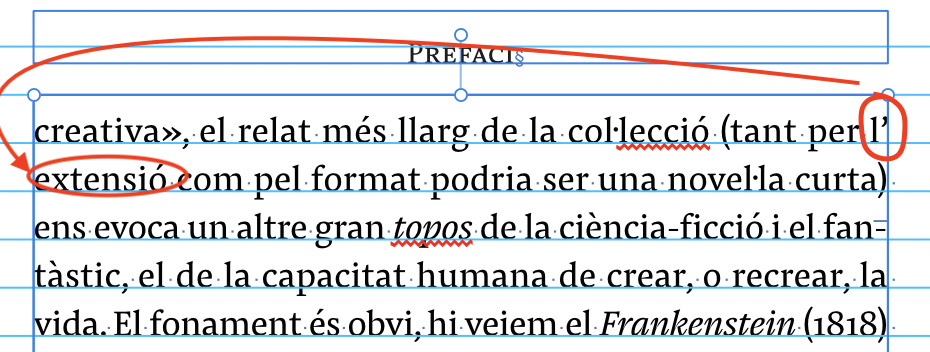
Raul Ciannella
Members-
Posts
22 -
Joined
-
Last visited
-
 Pšenda reacted to a post in a topic:
Master doesn't apply correctly
Pšenda reacted to a post in a topic:
Master doesn't apply correctly
-
Master doesn't apply correctly
Raul Ciannella replied to Raul Ciannella's topic in Desktop Questions (macOS and Windows)
Thank you! I managed adapting the master pages as you suggested. -
Master doesn't apply correctly
Raul Ciannella replied to Raul Ciannella's topic in Desktop Questions (macOS and Windows)
If I apply "Corpo articolo" I lose the footer. And anyway I tried and it presents the same problem, it doesn't show the header either. The multiple masters exist because I merged the single articles into one document, as I need both the individual article and the book as a whole. -
 Pšenda reacted to a post in a topic:
Master doesn't apply correctly
Pšenda reacted to a post in a topic:
Master doesn't apply correctly
-
Master doesn't apply correctly
Raul Ciannella replied to Raul Ciannella's topic in Desktop Questions (macOS and Windows)
Ok. You're right, but as you just put "try insert document" I thought it was some sort of function of Affinity I didn't know of. I'm not native english speaker. Here it is. test_forum.afpub -
 Raul Ciannella reacted to a post in a topic:
Master doesn't apply correctly
Raul Ciannella reacted to a post in a topic:
Master doesn't apply correctly
-
Master doesn't apply correctly
Raul Ciannella replied to Raul Ciannella's topic in Desktop Questions (macOS and Windows)
Can you elaborate? -
Hi All, I'm putting together an academic journal. I have two introductions (same introduction, two languages) to which I've applied the same masters. The first one displays the header correctly but the second show it as hidden text. It's like there was something there not allowing the text to show in the right place. It's driving me mad! Please help.
-
 Oufti reacted to a post in a topic:
Aligning footnotes' lines to words instead of numbers
Oufti reacted to a post in a topic:
Aligning footnotes' lines to words instead of numbers
-
Hi Mike, I write directly to you here about another topic because I know you can give a straight answer. I'm using the "book" function for the first time. Usually I edit my books in one document, but this one is an assignment for an academic journal with multiple articles by multiple authors and I thought it will make more sense have a book. My question is, once I set up the book with all the articles, front and back matter, if I need to make changes in the content would I do it on the single documents or directly on the book? Thank you
-
 MikeTO reacted to a post in a topic:
Aligning footnotes' lines to words instead of numbers
MikeTO reacted to a post in a topic:
Aligning footnotes' lines to words instead of numbers
-
 Raul Ciannella reacted to a post in a topic:
Aligning footnotes' lines to words instead of numbers
Raul Ciannella reacted to a post in a topic:
Aligning footnotes' lines to words instead of numbers
-
Thank you. It might also be caused by Affinity thinking the apostrophe is just another valid character to apply hyphenation to. The fact the problem is solved by changing prefix from 2 to 3 characters might imply that. Moreover, languages like Catalan have special phonetic graphic sign like the "l·l" (a double L with a dot in the middle, as in the word "il·lustració"). When hyphened, Affinity will wrongly separate the "l·" from the other "l". It could also be a fault in the Catalan Hyphenation dictionary.
- 20 replies
-
- fontastand
- fonts
-
(and 1 more)
Tagged with:
-
Checked, thank you. It's a real bummer. I'll try the workaround you suggest and then re-check manually. Should we communicate the bug? Thanks again. Raul
- 20 replies
-
- fontastand
- fonts
-
(and 1 more)
Tagged with:
-
OK, I modified a little your doc and placed the apostrophe example in the first line. test-catala.afpub
- 20 replies
-
- fontastand
- fonts
-
(and 1 more)
Tagged with:
-
Hi everybody. Not related to the previous topic, but regarding the same file. I'm doing a galley proofreading of the book and noticed that Publisher often leaves isolated letters (or letters with an apostrophe, hanging at the end of the line (as in the example) which is not really right. Is there an automatic way I can tell Publisher not to separate the letter+apostrophe with the following word? I created a "do not divide" character style but still I have to go word by word. Thank you.
- 20 replies
-
- fontastand
- fonts
-
(and 1 more)
Tagged with:




